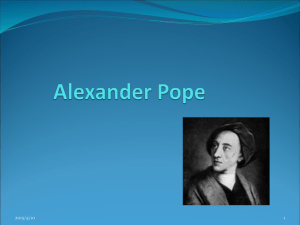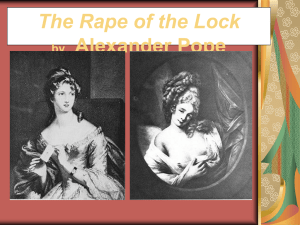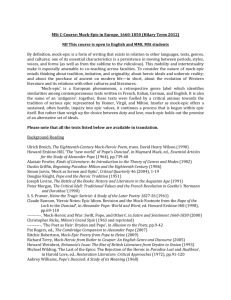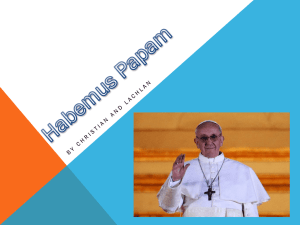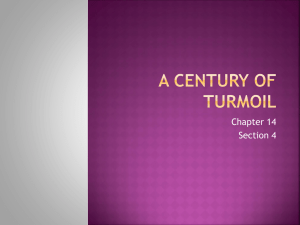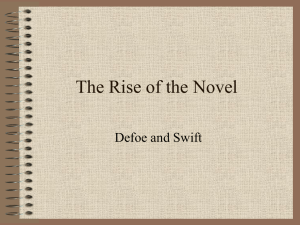Alexander pope
advertisement
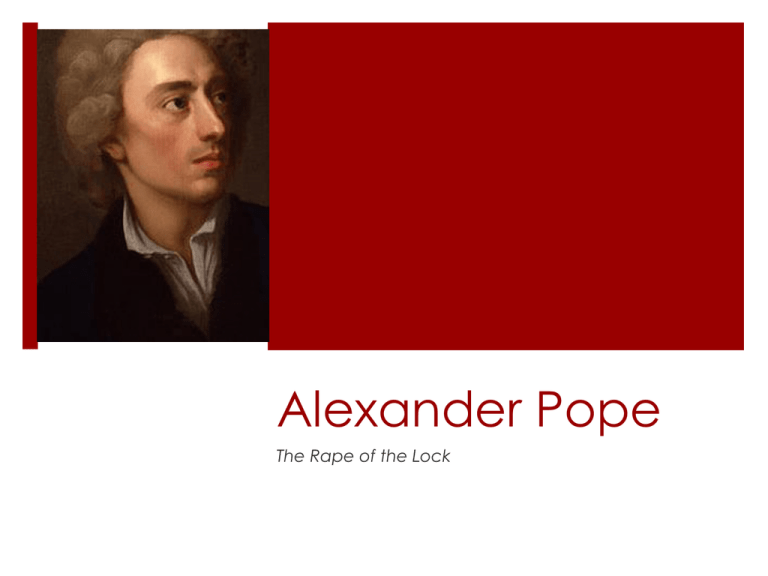
Alexander Pope The Rape of the Lock Pope’s Life Born May 21, 1688 (Restoration), London Crippled at 12; hunchback Never married, but involved with two women in his life Martha Blount and Lady Mary Wortley Montagu Never formally educated because he was Catholic Gained an appreciate for the classics and writing Conformed to strict writing rules Greatest work (at 24) was The Rape of the Lock, a mockheroic Financially independent through translations of the Iliad and the Odyssey Died 1744, Twickenham Pope’s Writing First Period Pastorals—1709 Two most important poems were Essay on Criticism (1711) and The Rape of the Lock (1714) Second Period Iliad translation (1715) Odyssey translation (1726) Third Period Dunciad (1728) Essay on Man (1734) 18th Century Background Augustan Age (1660-1780) Bracketed between “rigid scholarship” of the 17th cent. and scientific/religious skepticism of the 19th cent. Interest in society, and self as part of society All aspects—politician to servant—examined Satirized ruthlessly Writer depended on patron, but could also be independent Printing press came of age Expanding, healthy economy Civilized society = London; exotic ideas admired Literary Background Augustan Age (1660-1780) Basic rule—man had to follow “Nature” The pure standards of taste and judgment that should control man’s artistic endeavors Knowledge of classics and former civilizations Strict adherence of rules and regulations Heroic couplets (suitable for lofty themes) Art subservient to Nature Also called Reason and Common Sense Formalism stifled freedom of expression Various forms: mock epic, ode, epistle, and epigram Pope’s Methods Pope and the 18th Century No advantage of vernacular speech, but he used colloquialisms Mature outlook, poise and control, careful judgment Exposed shallow flaws in society Imitation Re-creation of a work Pope translated old into Augustan phraseology Pope’s Methods Pope and Society Poked fun at society, e.g. The Rape of the Lock Commentary on British legal system Biting satire against others Pope and the Classics Looked to Homer (favorite) and French classicism Pope and Didactic Poetry Teach lessons to society “Hope springs eternal in the human breast” and “A little learning is a dangerous thing” Pope’s Methods Pope and Poetic Form Heroic couplet “Laugh where we must, be candid where we can; But vindicate the ways of God to Man.” “The Rape of the Lock” Alexander Pope Satire & the Mock Heroic SATIRE: the use of irony, sarcasm, ridicule, or the like, in exposing, denouncing, or deriding vice, folly, etc. MOCK HEROIC is a form of satire that adapts the elevated heroic style of the classical epic poem to a trivial subject. The Epic Conventions • High formal diction • Invocation of the Muse • “machinery” (i.e. gods or supernatural figures) • Gods speak to hero in a dream • The arming of the hero • Sacrifice to the gods • Exhortation of the general to the troops • Catalog of the armies • Battle scenes • Descent into the underworld • Intercession of the gods • Ascension of the dead into the heavens Background Refashioned like Virgil’s Aeneid or Homer’s Odyssey Pope had three aims: Patch a feud between two well-known families (a lock of hair was stolen) Ridicule the shallowness and useless frivolity in the upper class Make fun of the epic conventions Historical Background Three prominent Roman Catholic families: the Carylls, the Fermors, and the Petres. Fermors had a daughter, Arabella. Petres had a son, Lord Petre. Lord Petre cut off a lock of Arabella’s hair as a joke, causing the bitter quarrel. John Caryll asked Pope if he would write a poem to heal the breach. Important Attributes Characters Belinda (Arabella Fermor) The Baron or Lord (Robert, Lord Petre of Essex) The Muse (John Caryll) Sir Plume (Sir George Browne) Thalestris, an Amazon (Lady Browne) Clarissa (?) Places The Mall Hampton Court The Ring Rosamonda’s Lake Important Attributes Use of sylphs Part of the “epic machinery” Borrowed from the classics The game of Ombre Structure of the poem Five cantos (sections) Regular rhyming couplets Research (due 12/12) Sylphs, salamanders, undines, gnomes and their connection to Paracelsus The game of Ombre Extra Credit: Learn how to play and teach us Mock epic, ode, epistle, and epigram Heroic couplets Patron of the arts (FYI: Latin, patronus)



